The Biostar X370GTN Mini-ITX Motherboard Review: AM4 Goes Tiny
by Gavin Bonshor on October 23, 2017 9:00 AM ESTSystem Performance
Not all motherboards are created equal. On the face of it, they should all perform the same and differ only in the functionality they provide - however this is not the case. The obvious pointers are power consumption, but also the ability for the manufacturer to optimize USB speed, audio quality (based on audio codec), POST time and latency. This can come down to manufacturing process and prowess, so these are tested.
Power Consumption
Power consumption was tested on the system while in a single ASUS GTX 980 GPU configuration with a wall meter connected to the Thermaltake 1200W power supply. This power supply has ~75% efficiency > 50W, and 90%+ efficiency at 250W, suitable for both idle and multi-GPU loading. This method of power reading allows us to compare the power management of the UEFI and the board to supply components with power under load, and includes typical PSU losses due to efficiency. These are the real world values that consumers may expect from a typical system (minus the monitor) using this motherboard.
While this method for power measurement may not be ideal, and you feel these numbers are not representative due to the high wattage power supply being used (we use the same PSU to remain consistent over a series of reviews, and the fact that some boards on our test bed get tested with three or four high powered GPUs), the important point to take away is the relationship between the numbers. These boards are all under the same conditions, and thus the differences between them should be easy to spot.
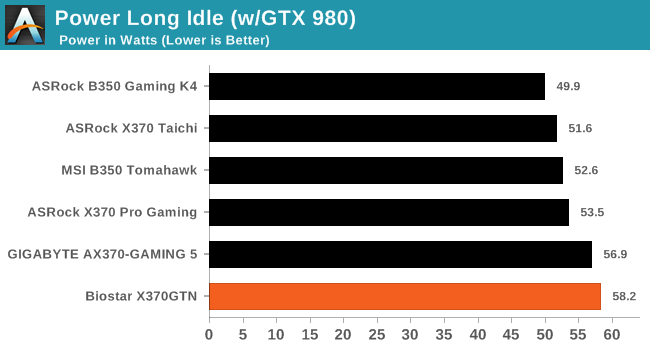
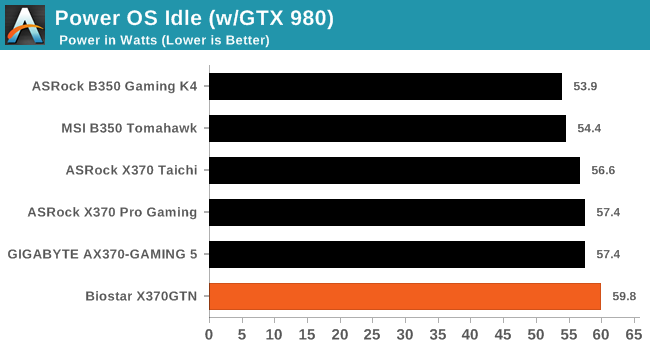
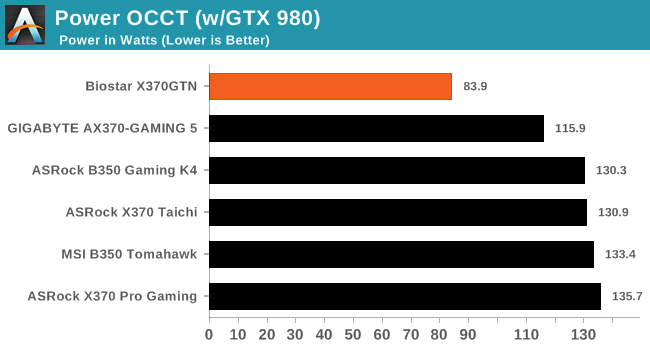
The Biostar X370GTN provided some very interesting power results which does indeed make things look a little odd. In all 3 of our power tests, the X370GTN provides results at different ends of the spectrum, with the power being high at idle, but very low at load. With smaller boards there might be inefficiencies leading to high power at low loads, and lower overall power at load, but this much of a difference was somewhat surprising/alarming. We confirmed the data a couple of times, especially given the 65W processor at hand and the system pulling 185W when overclocked. We're redoing the numbers again, and will update.
Non UEFI POST Time
Different motherboards have different POST sequences before an operating system is initialized. A lot of this is dependent on the board itself, and POST boot time is determined by the controllers on board (and the sequence of how those extras are organized). As part of our testing, we look at the POST Boot Time using a stopwatch. This is the time from pressing the ON button on the computer to when Windows starts loading. (We discount Windows loading as it is highly variable given Windows specific features.)
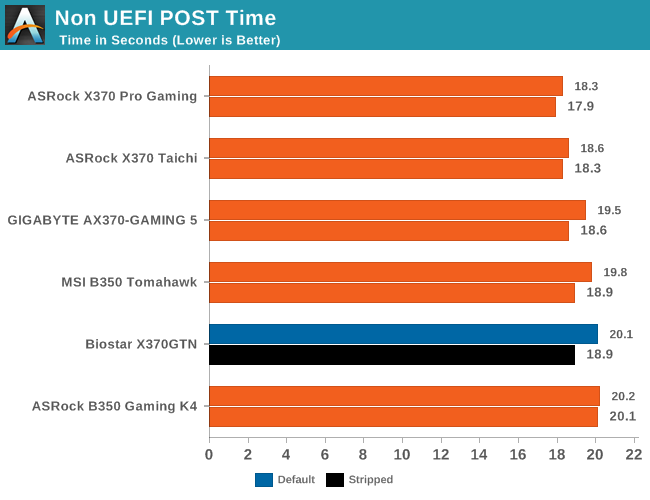
The Biostar X370GTN is marginally one of the slowest boards in our Non UEFI post time testing and disabling all the available controllers/fluff shaved a mere second or so off post times.
Rightmark Audio Analyzer 6.2.5
Rightmark:AA indicates how well the sound system is built and isolated from electrical interference (either internally or externally). For this test we connect the Line Out to the Line In using a short six inch 3.5mm to 3.5mm high-quality jack, turn the OS speaker volume to 100%, and run the Rightmark default test suite at 192 kHz, 24-bit. The OS is tuned to 192 kHz/24-bit input and output, and the Line-In volume is adjusted until we have the best RMAA value in the mini-pretest. We look specifically at the Dynamic Range of the audio codec used on board, as well as the Total Harmonic Distortion + Noise.
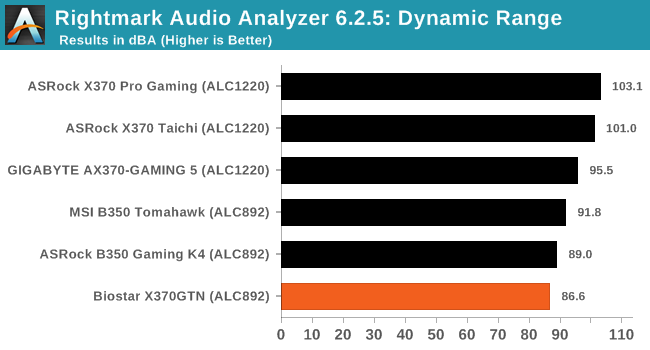
Performance in RMAA does yield some interesting results. Mini-ITX motherboards tend to suffer in audio performance due to electrical interference for the proximity of components. The newer codecs tend to handle this better, but against the other ATX boards we have tested, the ALC892 in the Biostar sits at the bottom of our comparison.
DPC Latency
Deferred Procedure Call latency is a way in which Windows handles interrupt servicing. In order to wait for a processor to acknowledge the request, the system will queue all interrupt requests by priority. Critical interrupts will be handled as soon as possible, whereas lesser priority requests such as audio will be further down the line. If the audio device requires data, it will have to wait until the request is processed before the buffer is filled.
If the device drivers of higher priority components in a system are poorly implemented, this can cause delays in request scheduling and process time. This can lead to an empty audio buffer and characteristic audible pauses, pops and clicks. The DPC latency checker measures how much time is taken processing DPCs from driver invocation. The lower the value will result in better audio transfer at smaller buffer sizes. Results are measured in microseconds.

Not all motherboard manufacturers optimize their motherboards for DPC latency, and the Biostar X370GTN is no different here. Although it looks like a poor result, this is more than acceptable for a board of this caliber and size.










31 Comments
View All Comments
BrokenCrayons - Monday, October 23, 2017 - link
Yeah, right now some of the value is lost by the lack of iGPUs on AM4, but the video outs are there for the APU version of Zen. I don't know if such an APU is worth waiting around to get since HTPC and SFF office boxes are probably fine with currently available hardware. Biostar will at least have a mITX board available for when the new APUs come out.mikestefoy - Monday, October 23, 2017 - link
I wouldnt buy anything less than HDMI v2DanNeely - Monday, October 23, 2017 - link
True, but these boards are perfectly fine for people who want to build smaller single GPU boxes and know they don't need a 2nd PCIe card. The limitations of mITX have gotten small enough that using it instead of miniATX for a smaller build is an increasingly attractive option.Valantar - Monday, October 23, 2017 - link
"One perhaps disappointing omission from the BIOS is the inability to call upon XMP profiles from any installed memory."This is just plain wrong. I don't know if it's your BIOS, your board, or your RAM, but mine can load XMP profiles just fine, and has done that since long before AGESA 1.0.0.6. I'm not running Ryzen-optimized RAM, either, just some TridentZ 3200 sticks that I bought before Ryzen even launched. This warrants some further investigation, though. I can easily provide screenshots if you want.
twnznz - Tuesday, October 24, 2017 - link
There's just one issue I am having with this board. Every so often, the system will fail a boot, but then will short cycle power 5x before booting back into CMOS defaults.I think there's something not quite right with the BIOS.
Valantar - Tuesday, October 24, 2017 - link
I have the same issue, but from what I can tell it only happens when I run my RAM at 3200 (what it's rated for, XMP profile). At 3000 or below (same timings), it's never happened to me, at least.Oxford Guy - Thursday, October 26, 2017 - link
XMP profiles, as far as I know, are only optimized for Intel's controllers. AMD tends to not perform as well so it makes sense that you would need to lower RAM speed to use those timings.Rene23 - Sunday, October 29, 2017 - link
anyone knows if these AM4 mini-its boards POST and boot without VGA card? need this for a head-less Linux server only ;-)karan101 - Wednesday, November 1, 2017 - link
<p><a href="http://www.mechanicalworld.in ">mechanicalworld</a></p>Duracellmumus - Thursday, May 3, 2018 - link
Let me save this little puppy: i choose this board, because my case have a special desing and need to use a big tower-like cooler on cpu and this board designe was the only one what can i choose.The board arived whit 1.0.0.4b bios. Simply put together with 1800x and G.skill cl14 ram and boot up.
I set 1,35V to ram, reboot, set 3200Mhz and XMP reboot. From that time it run without any problem. Later I try all of the bios settings, and choose the best conbination for smooth gameplay. It takes 42 reboot to find it.
I do update to 1.0.0.6 next month. Its able to set up manualy the memory timings, it way beter than leave the XMP on and the timeing "auto".
There is no any issue whit this x370GTN Biostar board.